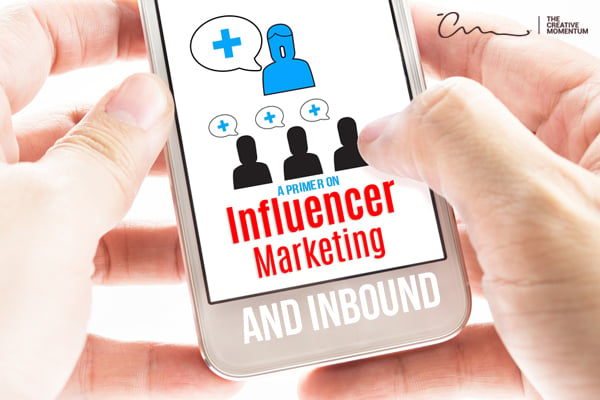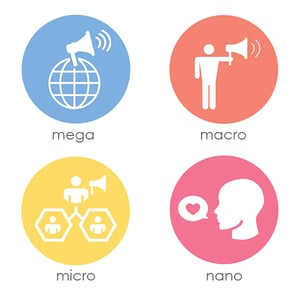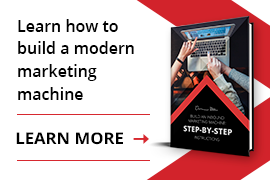 Influencer marketing has gotten a bad rap lately. Instagram is filled with “influencers” shamelessly promoting products—and making good money doing it! But it’s not only for social media. Businesses across various industries are using influencers to grow their brands. In fact, the influencer marketing industry is expected to reach $9.7 billion by the end of 2020.
Influencer marketing has gotten a bad rap lately. Instagram is filled with “influencers” shamelessly promoting products—and making good money doing it! But it’s not only for social media. Businesses across various industries are using influencers to grow their brands. In fact, the influencer marketing industry is expected to reach $9.7 billion by the end of 2020.
If done correctly, influencer marketing can be a powerful asset in your inbound toolbox to gain customers, increase brand recognition, and promote your products.
What Is Influencer Marketing?
Most marketing strategies aim for target customers. If you sell sports drinks, for example, you want to target people who live active lifestyles, which is a large group.. But what if there were another, smaller audience that could help promote your product, a marketing middleman, if you will?
If you got Michael Jordan to promote your sports drink, anyone who’s a fan of his (everyone) is instantly more interested in your product and some will convert into customers simply because MJ uses it! You only need to inspire (or pay) Mr. Jordan to use your product, and voila, his fans are now your fans.
A Brief History of Influencer Marketing
Influencer marketing didn’t start with Instagram and YouTube; it started way back in the 1920s. Instead of using celebrities to promote products, companies used characters. One of the most famous influencers of all time is a jolly guy named Santa Claus. Santa has been featured drinking Coca-Cola, eating M&Ms and driving Mercedes sports cars. Everyone loves Santa, and if a product is good enough for him, it’s good enough for you too!
Once radio and TV came along, people weren’t as interested if a fictional character used a product, which led to the rise of the celebrity influencer. It’s not hard to find old advertisements featuring Michael Jackson drinking a Pepsi or Wayne Gretzky on a box of Wheaties.
Today, influencer marketing has taken on yet another transformation with the rise of social media. In the past, to promote a product to a mass audience, you needed a TV or radio ad. These were expensive, and not every company could afford them. Social media, however, is cheap. Anyone with a large online following can be a successful influencer. With more opportunities and lower expenses, influencer marketing has exploded in the 21st century.
Influencer Marketing and the Inbound Methodology
Influencer marketing shouldn’t replace your inbound methods; it should enhance them. So yes, you still need to use proper SEO practices for your website. Influencer marketing is a great way to attract the right people to your brand, establish credibility and build beneficial relationships with potential customers, all of which are integral parts of inbound marketing. Think of influencer marketing as a turbo boost for your inbound race car.
Attract the Right Customers
Influencers are a great way to attract people to your brand. Better yet, they attract the RIGHT people more effectively than almost any other form of advertising. Today, traditional advertising has far less of an impact on customers than it used to. Almost 50% of consumers use ad blockers when surfing the internet.
But people frequently go to social media and YouTube to check on their favorite celebrities and personalities. These influencers have a pre-built following of niche customers. All you have to do is tap into it.
By working with an influencer, you get your product in front of thousands of viewers who actively follow this person because they look to them for information and trusted recommendations. It's one of the oldest, yet most effective, marketing strategies in the world: word-of-mouth. Just make sure to choose an influencer who has the proper audience. Bill Nye is a popular online personality, but he probably couldn’t sell many women’s shoes.
Establish Authority
Another aspect of inbound marketing is to establish yourself as an expert in your field. Typically, this takes months—if not years—to develop, but if you link your product with the right influencer, their credibility is now your credibility.
Because influencers have already established themselves as experts in their respective fields, if consumers see them using a product, they automatically assume it’s the best available. When looking for influencers, credibility may be more important than reach. An influencer with 50k followers who has proven expertise in a field might be more effective than an influencer with 100k followers who lacks credibility. Balancing authority with total reach is a tightrope in influencer marketing.
Build a Relationship
Customer relationships are everything in inbound marketing. Influencer marketing can help to create an opportunity for you to build relationships with potential customers who might not be familiar with your brand.
Influencers already have a large following, and people engage with every video, picture, or blog they post. When you link your brand with an influencer, you’ve opened a dialogue with all these people. Comment on posts, respond to followers, and engage! Build those relationships and establish a strong brand persona. If customers feel like they know your brand, they’ll be more likely to use your products or services.
4 Types of Influencers
Not all influencers are created equal. There are six types for brands to choose from, and there are pros and cons to each.
- Mega: Famous celebrities with massive followings of more than one million people. They might not be subject matter experts or really care about your product, but they certainly have reach. They’re typically the most expensive.
- Macro – Similar to mega influencers, except they rose to stardom through the internet. They have massive reach, between 100,000 to 1 million followers, and generally have some expertise in their fields. They’re typically bloggers, vloggers, social media stars and podcasters.
- Micro – Experts in their field with 1,000 to 100,000 followers. They might not have the same reach as mega and macro influencers, but they have the niche audience and the expertise to back it up. They’re also less expensive than the larger influencers.
- Nano – Regular, everyday people who promote your brand because they love it. While they might not have the reach—fewer than 1,000 followers—they’re typically the most invested in your product and have the highest level of engagement with their followers.
The influencer who’s best for your business depends on your marketing goals. A micro influencer with subject matter expertise might offer a greater return on your marketing investment than a mega influencer with no credibility.
Does Influencer Marketing Really Work?
In a word: yes! People love online personalities. According to a 2019 survey, every dollar spent on influencer marketing returned $5.20 on average. For the top 13% of brands, their ROI for each dollar was $20 or more.
Partnering with influencers within your niche is a great way to get your product in front of the right people, increase your brand’s credibility and start building relationships. Now that you know the basics, you’re primed and ready to use influencer marketing to boost your inbound strategy.



